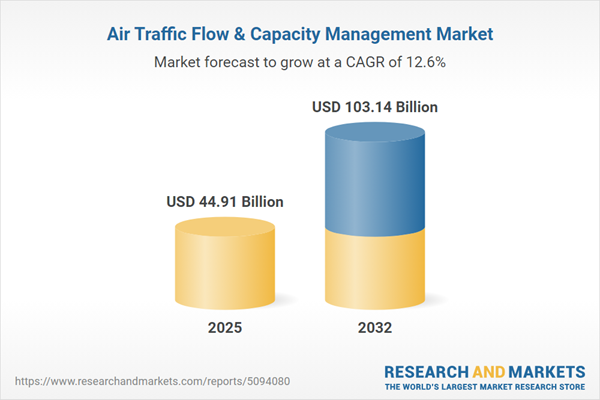Speak directly to the analyst to clarify any post sales queries you may have.
The air traffic flow and capacity management market is central to aviation’s digital modernization, presenting senior executives with advanced tools to drive operational resilience, streamline compliance, and foster agile management in today’s complex airspace landscape.
Market Snapshot: Air Traffic Flow and Capacity Management Market Trends
Anchored by steady revenue expansion and a stable compound annual growth rate, the air traffic flow and capacity management market stands out due to the aviation sector’s adoption of analytics-driven decision processes and emerging digital infrastructures. Integrated technology platforms are now critical, as both passenger and cargo operators invest in innovation to minimize disruptions, manage congestion, and rapidly adapt to regulatory changes. This continuous integration of advanced solutions cultivates operational flexibility and fortifies global competitiveness, especially as organizations navigate increasing airspace complexity and regulatory expectations.
Scope & Segmentation: Decision-Critical Insights
Senior leaders gain clear, actionable perspectives on market segmentation, equipping them to refine efficiency and steer robust strategic planning across varied regions and technological environments. Each segment reflects pressing operational requirements and evolving industry practices, addressing the realities of both established and high-growth markets.
- Service Types: Comprehensive consulting, integration, deployment, testing, and maintenance enable tailored use-case execution and support both hardware and software needs.
- Functional Areas: Real-time tactical management and capacity planning improve airspace control and support future-facing traffic forecasting across local and global networks.
- Application Domains: Core solutions support collaborative decisions, optimize airport and network demand management, and uphold international safety and compliance standards as they develop.
- Targeted End Users: Air navigation service providers, airlines, and airports benefit through targeted solutions that reflect each organization’s operational imperatives and stakeholder expectations.
- Geographic Coverage: Extends across Americas, Europe, Middle East & Africa, and Asia-Pacific, addressing region-specific adoption rates, diverse regulatory regimes, and hubs of technical leadership.
- Enabling Technologies: Cloud platforms, artificial intelligence, machine learning, digital towers, satellite surveillance, and advanced communications promote unified and synchronized air traffic control operations.
- Key Market Players: Sector advancement is shaped by Indra Sistemas S.A., Thales S.A., Frequentis AG, L3Harris Technologies, Raytheon Technologies, Honeywell International, Saab AB, Adacel Technologies, Ultra Electronics, and Airbus SAS.
Key Takeaways: Strategic Insights for Senior Leaders
- Digital and connected infrastructures help improve operational reliability and enable seamless airspace management across international and regional boundaries.
- Adoption of modular, scalable platforms strengthens regulatory alignment and supports expansion, maintaining high levels of efficiency and oversight.
- Proactive resource planning and scenario analysis position organizations to respond efficiently to changing traffic volumes and operational uncertainties.
- Investing in platforms with clear upgrade pathways allows for continuous adaptation to strategic shifts and emerging industry technologies.
- Digital collaboration frameworks and cross-stakeholder partnerships standardize processes, enhance interoperability, and accelerate best-practice adoption industry-wide.
- Refined risk management tools empower organizations to adjust quickly to shifting regulations and industry disruptions, building capacity for sustained adaptability.
Market Tariff Impact: Procurement and Sourcing Trends
Current United States tariff measures are reshaping procurement strategies in air traffic flow and capacity management. Organizations prioritize domestic sourcing and resilient, diversified supply chains to contain operational expenses and ensure sustained delivery. Modular architectures and enhanced collaboration with suppliers help organizations mitigate risk, supporting stable operations in an environment of global trade uncertainty.
Methodology & Data Sources
Findings are based on multi-source research, synthesizing expert interviews with airport planners, technology vendors, and flight operations specialists. The combined qualitative and quantitative analysis reflects present market dynamics, policy evolution, and advances in digital technologies that inform senior leadership decisions.
Why This Report Matters
- Enables aviation executives to confidently lead digital transformation, positioning their organizations to adapt to regulatory and operational evolution.
- Supports improved procurement and supply strategies, highlighting actionable risk insights stemming from tariffs and global supply chain interdependencies.
- Delivers practical, segment-specific intelligence necessary to support sustainable growth, foster industry collaboration, and reinforce organizational resilience.
Conclusion
This comprehensive analysis equips aviation executives to expedite digital innovation, strengthen industry partnerships, and deliver robust, resilient air traffic flow management amid the evolving dynamics of global aviation.
Additional Product Information:
- Purchase of this report includes 1 year online access with quarterly updates.
- This report can be updated on request. Please contact our Customer Experience team using the Ask a Question widget on our website.
Table of Contents
3. Executive Summary
4. Market Overview
7. Cumulative Impact of Artificial Intelligence 2025
Companies Mentioned
The companies profiled in this Air Traffic Flow & Capacity Management market report include:- Indra Sistemas, S.A.
- Thales S.A.
- Frequentis AG
- L3Harris Technologies, Inc.
- Raytheon Technologies Corporation
- Honeywell International Inc.
- Saab AB
- Adacel Technologies Limited
- Ultra Electronics Holdings plc
- Airbus SAS
Table Information
| Report Attribute | Details |
|---|---|
| No. of Pages | 198 |
| Published | October 2025 |
| Forecast Period | 2025 - 2032 |
| Estimated Market Value ( USD | $ 44.91 Billion |
| Forecasted Market Value ( USD | $ 103.14 Billion |
| Compound Annual Growth Rate | 12.6% |
| Regions Covered | Global |
| No. of Companies Mentioned | 11 |









